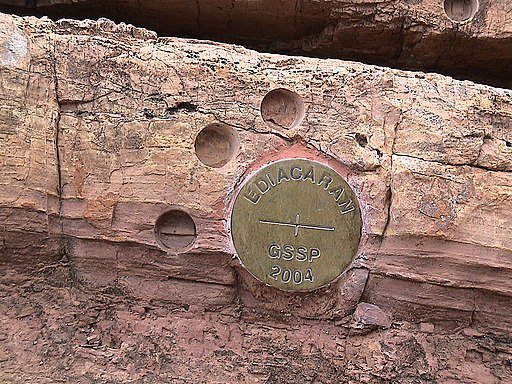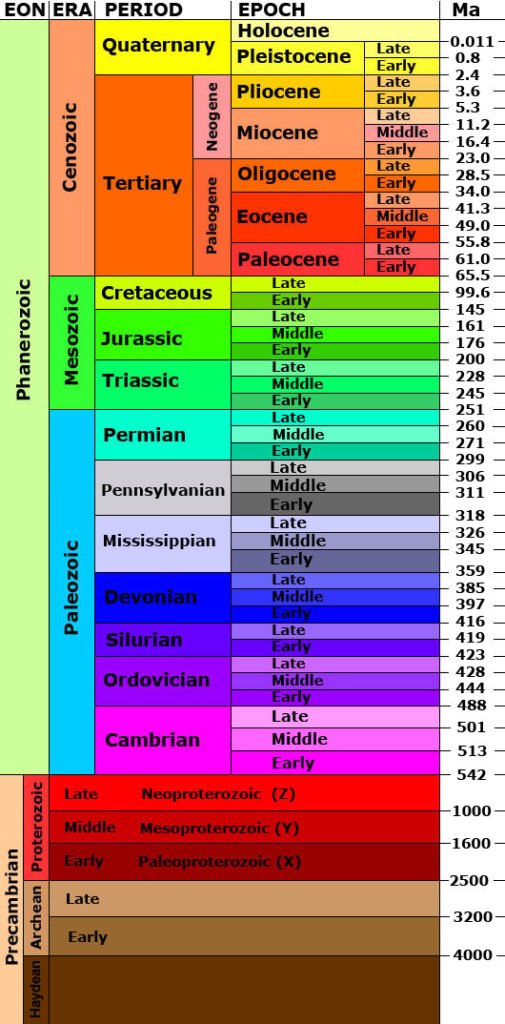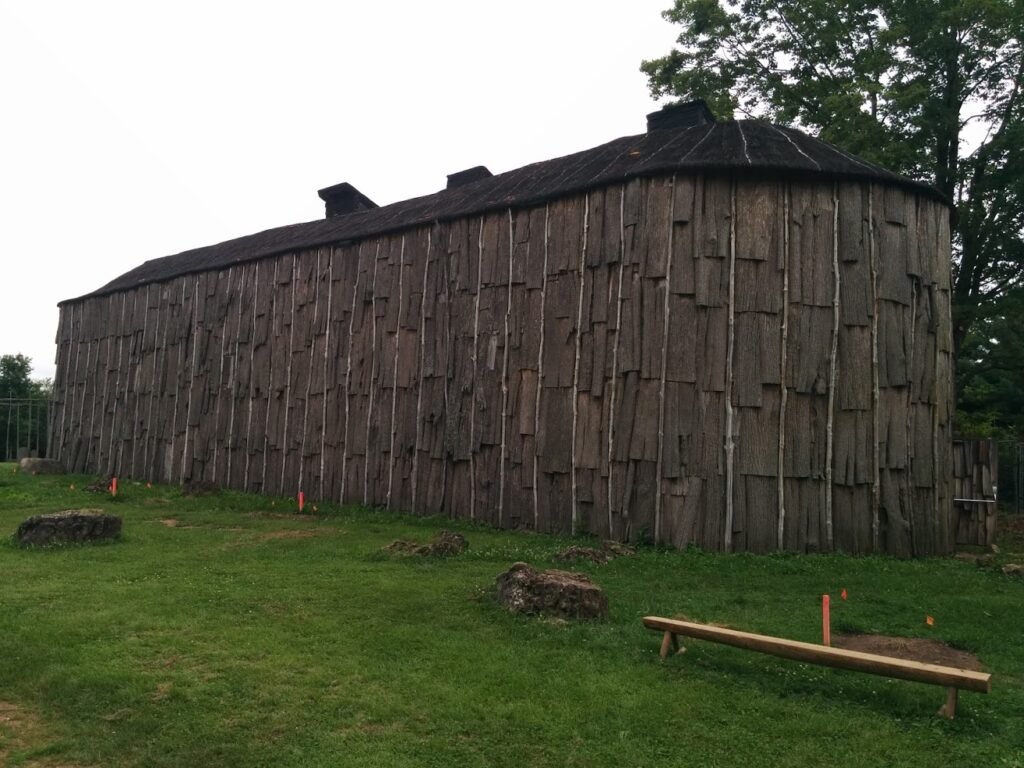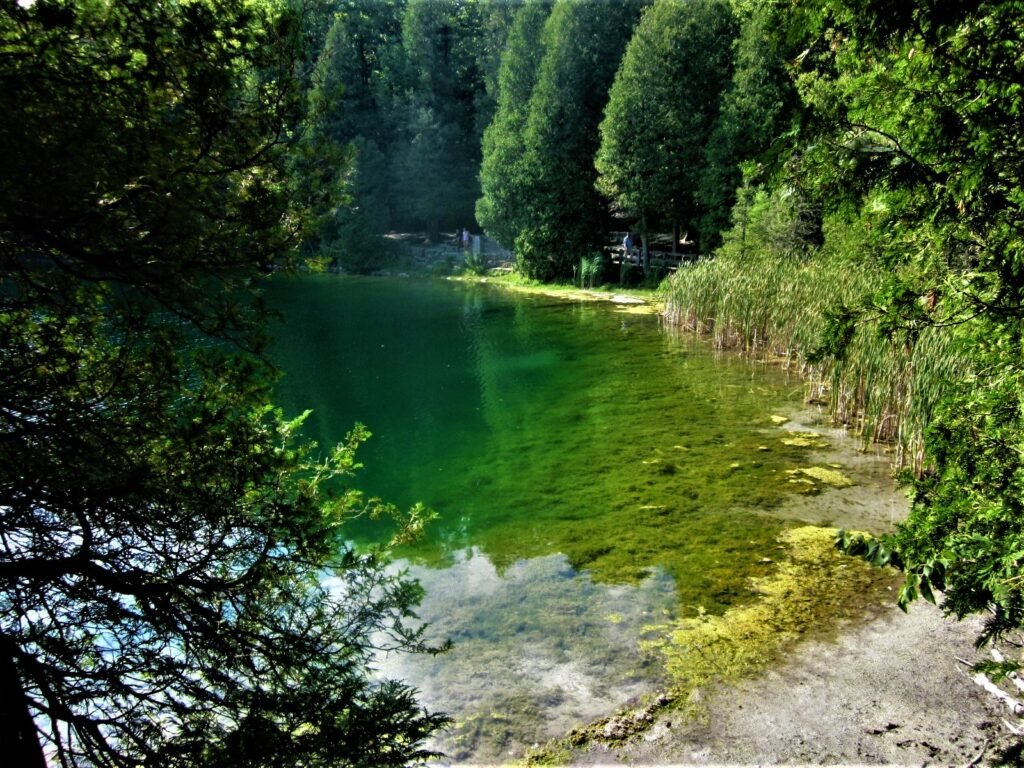Crawford Lake is a small lake near Milton Ontario, also called “Kionywarihwaen” meaning “where we have a story to tell” in the Wendat language. The lake was just designated as the “Golden Spike” for Earth’s proposed new epoch: The Anthropocene. The lake represents an extremely well preserved example of the impact humans have had on the geology and environment of the Earth in the last century. If the Anthropocene is officially accepted as a new epoch, then Crawford Lake will receive a physical golden spike in the rock to highlight the sediment layers that signal the new epoch.

First, let’s back up a bit: What exactly is an epoch? And what is the Anthropocene?
You may have seen a graph such as the one below that demonstrates the segments of geologic time. An epoch is one of the categories of time on the geologic time scale. From largest to smallest, the categories are: eon, era, period, epoch, and age. Each of these categories is separated by a significant event in geologic history, for example, the asteroid that finished off the dinosaurs defines the end of the Cretaceous period and the start of the Tertiary period.

The Anthropocene is a potential new epoch that is proposed to have started around 1950. This epoch is defined by human impact on the Earth’s climate, environment and geology. Many geologists argue that the impacts of human development can be seen in the rock record, and mark a distinct change from the geology of the Earth pre-1950.
So what does this have to do with a small lake near Milton, Ontario? Crawford Lake has a very unique ecosystem. The different levels of water in Crawford Lake do not mix together. The lake is very deep and not very wide, so the top layers of the water do not mix with the bottom layers. Lakes like this are called meromictic. Although in most meromictic lakes the bottom layer of water is oxygen-depleted, in Crawford Lake, the whole water column is oxygenated, making it especially unique. The layers of water at the bottom of the lake are virtually undisturbed by currents. The lack of sea life in the deep of the lake also ensures that the sediments are not disturbed from burrowing organisms.

These unique features of Crawford Lake mean that each layer of sediment is not mixed with the last, and each yearly deposition of sediment can be distinguished from the last. There is nearly 10,000 years of layering that can be seen at the bottom of Crawford Lake. When geoscientists first recognized this, they were excited to find corn pollen preserved in layers from the Middle Ages, supporting the theory that the peoples of the time were farming corn. This also led to the discovery of a nearby Indigenous settlement with longhouses from the 15th Century.

Now however, the layers are being examined again for evidence of human-related change. An increase in carbon-based particles in the 1950s reflects the increase in coal-fired steel-making in nearby Hamilton, Ontario. Nuclear testing has created an increase in plutonium in some of the layers. Additionally, nitrogen isotopes have been changed due to fertilizers and there’s evidence of acid rain. These are all further evidence that support the Anthropocene.
So what happens next? The Anthropocene Working Group, part of the International Commission on Stratigraphy, is still determining whether or not the evidence supports the proposed epoch. It’s still possible that the International Commission on Stratigraphy will ultimately decide that there is not enough evidence to proclaim the start of the Anthropocene. Alternatively, they could decide that the Crawfordian age has begun, but that we are still in the Holocene epoch. Or they will accept the Anthropocene epoch and the Crawfordian era as the newest unit of geological time.
If this happens, this will be the first epoch influenced by and observed by humans. It will also represent concrete evidence that humans have irreversibly changed the nature of the Earth down to even the rock record. This is a huge step forward in scientific knowledge and understanding of the interactions between humans and geology.

For more information about Crawford Lake, check out this interactive illustrated article from the Washington Post.
Sources:
CBC Canada’s Crawford Lake chosen as ‘golden spike’ to mark proposed new epoch
CBC A new geological epoch, the Anthropocene, has begun, scientists say
Yale Environment: A Golden Spike Would Mark the Earth’s Next Epoch: But Where?
The Washington Post: Crawford Lake shows humans started a new chapter in geologic time, scientists say
Canadian Geographic: The Anthropocene is here — and tiny Crawford Lake has been chosen as the global ground zero
Conservation Halton: Crawford Lake Studies
International Society for Diatom Research: A small lake with a large story to tell: what does it take to represent an Epoch

Veronica Klassen is the Manager of the Foundation’s blog – Beneath Your Feet: A Geoscience Blog. She studied Arts and Science at McMaster University with a minor in Earth Science and has a Master’s in Science Communication from Laurentian University. She is passionate about making science accessible and engaging to the public.

